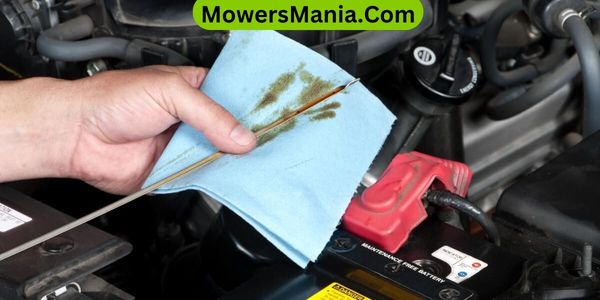Wondering what the proper oil level in your lawn mower should be? Keeping the right amount of oil in your mower is crucial for its performance and longevity. It’s not something you want to overlook.
Maintaining the correct oil level ensures that your engine stays lubricated, reducing wear and tear on its components. Plus, it helps keep things running smoothly every time you mow.

So, what’s the right oil level for your lawn mower? Let’s find out.
Importance of Proper Oil Level
Maintaining the correct oil level in your lawn mower is vital for optimal engine performance and longevity. Without the right amount of oil, the engine components can experience excessive friction and heat, leading to premature wear and potential damage.
When the oil level is too low, it can also result in inadequate lubrication, causing the engine to work harder and less efficiently. On the other hand, overfilling the oil can lead to increased pressure within the engine, potentially causing oil leaks and other issues.
Additionally, the oil in your lawn mower serves to clean, cool, and protect the engine, ensuring smooth operation and reducing the risk of overheating.
By regularly checking and maintaining the proper oil level, you can extend the life of your lawn mower and save yourself from costly repairs or replacements.
It’s a simple yet crucial task that can significantly impact the performance and durability of your equipment. So, make it a habit to check and top up the oil in your lawn mower to keep it running smoothly for years to come.
Checking the Oil Level
To check the oil level in your lawn mower, start by removing the oil dipstick and wiping it clean with a cloth. Then, reinsert the dipstick all the way back into the oil fill tube and make sure it’s fully seated.
After that, pull it out again to check the oil level. The dipstick has markings to indicate the proper oil level range. Ideally, the oil should fall between the ‘full’ and ‘add’ marks on the dipstick.
If the oil level is below the ‘add’ mark, you’ll need to add more oil. On the other hand, if the oil level is above the ‘full’ mark, you may need to drain out some oil to bring it to the correct level.
It’s crucial to ensure that the mower is on a level surface when checking the oil level for accuracy.
Regularly checking and maintaining the proper oil level in your lawn mower will help to ensure smooth operation and prolong the life of your equipment.
Adjusting High Oil Level

You can resolve a high oil level in your lawn mower by draining out the excess oil until it reaches the proper level indicated on the dipstick.
Begin by placing a drain pan beneath the mower’s oil drain plug. Loosen the plug with a wrench and carefully remove it, allowing the excess oil to drain into the pan. Once the oil has been drained, wipe the area around the drain plug and reinsert it securely.
Next, check the oil level using the dipstick. If the level is still too high, continue draining small amounts of oil at a time until it reaches the correct level. It’s crucial not to overfill the oil reservoir, as this can lead to engine damage and performance issues.
Once you’ve achieved the proper oil level, securely tighten the oil cap and wipe away any spills or drips.
Remember to dispose of the excess oil responsibly by taking it to a recycling center or an automotive store that accepts used oil.
With the oil level adjusted to the appropriate amount, your lawn mower should operate at its best.
Dealing With Low Oil Level
If you notice a low oil level in your lawn mower, top it up with the recommended oil until it reaches the proper level indicated on the dipstick. Running a lawn mower with low oil can cause serious damage to the engine.
Follow these steps to deal with a low oil level:
- Check the Oil Level: Turn off the engine and let the mower sit for a few minutes to allow the oil to settle. Remove the dipstick, wipe it clean, reinsert it, and then check the oil level again to confirm it is low.
- Top Up with Oil: Add small amounts of the recommended oil through the oil fill opening. After each addition, wait for a few moments to allow the oil to settle, then recheck the level with the dipstick until it reaches the proper level.
- Run the Engine: Start the engine and let it run for a few minutes. Check for any leaks around the oil fill cap or drain plug. If there are leaks, tighten the cap or plug as needed.
| Steps | Instructions |
|---|---|
| 1. Check the Oil Level | Turn off the engine, let it sit, and check the oil level with the dipstick. |
| 2. Top Up with Oil | Add recommended oil in small amounts, allowing time to settle, and recheck the level. |
| 3. Run the Engine | Start the engine, check for leaks, and tighten the cap or plug if necessary. |
Maintaining Optimal Oil Level

After topping up the oil to the proper level, regularly check the dipstick to ensure the oil remains at the recommended capacity. This is crucial for maintaining the optimal performance and longevity of your lawn mower.
Here are three simple steps to help you maintain the optimal oil level:
- Regular Inspections: Make it a habit to inspect the oil level before each use of the lawn mower. This quick check can prevent potential damage to the engine caused by low oil levels.
- Scheduled Checks: Set a schedule for checking the oil level, especially if your lawn mower sees frequent use. A good rule of thumb is to inspect the oil level at least once a month during the mowing season.
- Top-Up as Needed: If you notice that the oil level is below the recommended capacity, add the necessary amount of oil to bring it back to the optimal level. Use the manufacturer-recommended oil type and grade for the best results.
Frequently Asked Questions [FAQs]
Can I Use Any Type of Oil in My Lawn Mower, or Does It Need a Specific Type?
You should always use the specific type of oil recommended for your lawn mower. Using the wrong oil can cause damage to the engine. Check your mower’s manual for the correct oil type.
How Often Should I Change the Oil in My Lawn Mower?
You should change the oil in your lawn mower at least once a year or after 25 hours of use. Regular oil changes help maintain engine performance and prolong the life of your mower.
What Are the Signs That My Lawn Mower May Be Burning Oil?
If your lawn mower is burning oil, you may notice blue smoke coming from the exhaust, a decrease in engine performance, or the need to add oil more frequently. It’s important to address this issue promptly.
Is It Necessary to Use a Funnel When Adding Oil to My Lawn Mower?
Yes, it’s necessary to use a funnel when adding oil to your lawn mower. This helps prevent spills and ensures that the oil is poured accurately into the engine, maintaining the proper oil level for optimal performance.
Can I Overfill My Lawn Mower With Oil, and What Are the Consequences if I Do?
Yes, you can overfill your lawn mower with oil. This can lead to engine damage, increased oil consumption, and reduced performance. Always check and maintain the proper oil level to ensure your lawn mower operates efficiently.
Conclusion
So, make sure to regularly check and maintain the proper oil level in your lawn mower to keep it running smoothly.
It only takes a few minutes to check and adjust the oil level, but it can make a big difference in the performance and lifespan of your lawn mower.
Keep your machine in top condition by keeping an eye on the oil level and making adjustments as needed.



